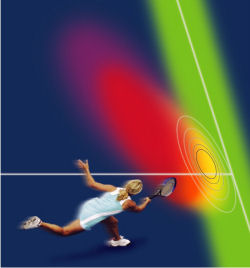The Department's Professor Daniel Wolpert has been awarded a Wellcome Trust Programme Grant to study the computations the brain performs when controlling our movements.

Movement is the only way we have of interacting with the world, whether foraging for food or attracting a waiter's attention. Indeed, all communication, including speech, sign language, gestures and writing, is mediated via the motor system. Taking this viewpoint, the purpose of the human brain is to use sensory signals to determine future actions.
However, the effortless ease with which we move our arms, our eyes, even our lips when we speak masks the true complexity of the control processes involved. This is evident when we try to build machines to perform human control tasks. While computers can now beat grandmasters at chess, no computer can yet control a robot to manipulate a chess piece with the dexterity of a six-year-old child. Therefore understanding brain processing could lead to dramatic improvements in technology.
A major area of Wolpert's research programme is to understand how the brain deals with uncertainty inherent in the world and in our own sensory and motor systems. For example, our only access to knowledge about the world is through our senses which provide information that is usually corrupted by random fluctuations, termed noise, which lead to variability in our perception - try localising your hand when it is hidden under a table. In addition sensory inputs may provide ambiguous information about the possible states of the environment - you can't tell if a teapot is full or empty just by looking at it. Moreover, when we act on the world through our motor system, the commands we send to our muscles are also corrupted by variability or noise which leads to inaccuracy in our movements.
This combined sensory and motor variability limits the precision with which we can perceive and act on the world. Society places a premium on those of us who can reduce the overall variability of our sensory processing and motor outputs - financial rewards accrue to those who can reliably hit a small white ball into a hole several hundred yards away using a long metal stick.
Wolpert's group have shown that not only does society care about reducing variability but that the brain dedicates its resources to reducing the uncertainty and variability in sensory and motor processing.
To investigate how the brain reduces uncertainty they have developed state-of the art robotic interfaces and virtual reality systems that allow researchers to control the environment as well as the visual feedback that volunteers experience during skill learning tasks. Using this apparatus they have recently shown that when we learn a new task, although we are not aware of it, our brains combine our prior experience with our current sensory input in an optimal fashion.
The precise way in which these two sources of information are combined is given by a formula known as Bayes rule after Thomas Bayes who was an 18th century English Presbyterian minister. The fundamental idea of Bayes rule is that probabilities can be used to represent the degree of belief in different propositions about ourselves and the world - such as the probability that one is looking at an apple or tennis ball or that one's hand is at different possible locations when hidden under a table-top. Bayes rule specifies the optimal way that these probabilities should be updated as new information is received. Bayesian methods are currently a major component of statistics and Wolpert's group is investigating to what extent they may provide a unifying mechanism by which the brain makes estimates about our own body and the world and chooses optimal actions.

